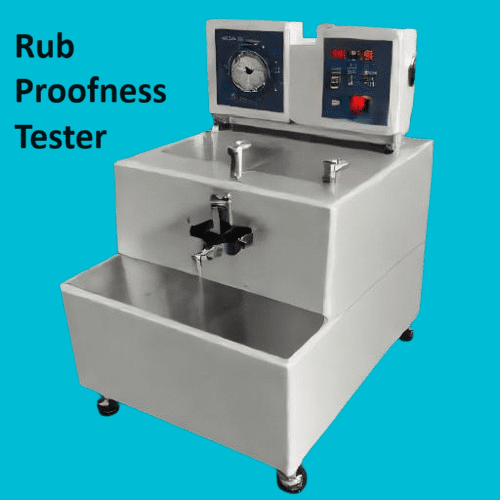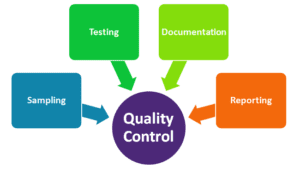In the dynamic world of packaging and printing, maintaining high-quality standards is crucial for ensuring customer satisfaction and product longevity. One of the critical challenges faced by these industries is the durability of printed materials, especially under conditions of handling and shipment. The Rub Proofness Tester, also known as the Rub/Scuff Tester, is an indispensable tool designed to address this challenge. This article delves deep into the Rub Proofness Tester, exploring its functionality, applications, benefits, and significance in quality control.
Understanding the Rub Proofness Tester
The Rub Proofness Tester is a specialized instrument used to measure the resistance of printed paper, board, and other materials to rubbing. It also evaluates the extent of color transfer from printed or coated materials during rubbing, a condition frequently encountered during the handling and shipment of packaged goods. The tester is based on Scheifer’s uniform rubbing action principle, ensuring consistent and reliable results.
Components and Design
The Rub Proofness Tester comprises two main discs, with pressure between them determined by a dead load applied to the upper disc. Both discs rotate at the same angular speed, ensuring that the relative velocity between all points on each disc is uniform. This uniform rubbing action is essential for obtaining accurate and repeatable test results. The robust stainless steel construction of the tester ensures durability and longevity, making it a valuable asset to any quality control laboratory.
A high-speed blower is integrated into the design to remove dismantled print or paper particles during the rubbing action. This feature is crucial for accurate evaluation of the test results, as it prevents the accumulation of debris that could affect the rubbing process. The tester’s simplicity and ease of operation, combined with its low maintenance requirements, make it an ideal choice for quality control and research and development (R&D) laboratories.

Technical specifications of the Rub Proofness Tester
| Specification | Details |
| Model | Rub Proofness Tester |
| Principle | Schiefer’s Uniform Rubbing Action |
| Construction | Robust and Stainless Steel |
| Discs | Two rotating discs |
| Pressure Determination | Dead load applied to the upper disc |
| Disc Rotation | Same angular speed for both discs |
| Relative Velocity | Uniform relative velocity between all points |
| High-Speed Blower | Integrated for removing dismantled particles |
| Applications | Printing ink, paper, board, plastic, leather |
| Operation | Simple and easy to operate, no maintenance |
| Accuracy | Fast, repeatable, and accurate results |
| Pressure Calibration | Calibrated pressure weight |
| Test Bed Rotation | Same angular speed as the discs |
| Dimensions | Specific dimensions |
| Weight | Specific weight |
| Power Supply | Voltage and frequency |
| Environmental Conditions | Operating temperature and humidity ranges |
| Compliance | Relevant standards and certifications |
| Warranty | Warranty details, if available |
Applications
The Rub Proofness Tester is versatile and can be used across various industries. Some of its primary applications include:
- Printing Industry:
- Evaluating the durability of printing inks.
- Ensuring the quality of printed materials, such as magazines, brochures, and packaging.
- Packaging Industry:
- Assessing the resistance of printed packaging materials to rubbing and scuffing.
- Ensuring the integrity and appearance of packaging during shipment and handling.
- Paper and Board Industry:
- Testing the durability of different types of paper and board.
- Ensuring the quality of paper products used in packaging and printing.
- Plastic and Leather Industry:
- Evaluating the resistance of printed or coated plastics and leather to rubbing.
- Ensuring the longevity and appearance of printed or coated plastic and leather products.
Salient Features
The Rub Proofness Tester boasts several key features that make it an essential tool for quality control:
- Uniform Rubbing Action: The tester’s design ensures uniform relative velocity between all points on the discs, providing consistent and reliable results.
- Robust Construction: Made of stainless steel, the tester is durable and capable of withstanding rigorous use in quality control laboratories.
- High-Speed Blower: This feature removes dismantled print or paper particles during the rubbing action, ensuring accurate test results.
- Ease of Use: The tester is simple to operate, requiring minimal training and maintenance.
- Fast and Repeatable Results: The tester delivers quick, accurate, and repeatable results, making it ideal for quality control and R&D applications.
Importance in Quality Control
The Rub Proofness Tester plays a vital role in ensuring the quality and durability of printed materials. By evaluating the resistance of materials to rubbing and scuffing, it helps manufacturers identify potential issues before they reach the consumer. This proactive approach to quality control not only enhances customer satisfaction but also reduces the risk of product returns and complaints.
In the printing industry, the tester ensures that printing inks and materials can withstand the rigors of handling and shipment. This is particularly important for high-end printed materials, such as magazines and brochures, where the appearance and quality of the print are critical.
In the packaging industry, the tester helps ensure that packaging materials can protect the product throughout the supply chain. By assessing the durability of printed packaging materials, manufacturers can ensure that their products arrive at their destination in perfect condition.
Case Studies
To illustrate the practical applications and benefits of the Rub Proofness Tester, let’s explore a few case studies from different industries:
- Printing Industry: A leading magazine publisher implemented the Rub Proofness Tester to evaluate the durability of their printed covers. By identifying inks and coatings that performed well under rubbing conditions, they were able to significantly reduce the number of customer complaints related to scuffed covers. This not only improved customer satisfaction but also enhanced the perceived value of their publications.
- Packaging Industry: A global packaging company used the Rub Proofness Tester to assess the resistance of their printed packaging materials to rubbing during shipment. By selecting materials that demonstrated high resistance to scuffing, they were able to ensure that their packaging maintained its integrity and appearance throughout the supply chain. This led to a reduction in product returns and increased customer confidence in their brand.
- Paper and Board Industry: A paper manufacturer utilized the Rub Proofness Tester to evaluate the durability of their products used in high-end packaging. By identifying paper types that performed well under rubbing conditions, they were able to market their products as premium, high-durability options for luxury packaging. This differentiation allowed them to capture a niche market and increase their revenue.
- Plastic and Leather Industry: A manufacturer of printed plastic and leather goods used the Rub Proofness Tester to ensure the longevity and appearance of their products. By selecting inks and coatings that demonstrated high resistance to rubbing, they were able to produce high-quality products that maintained their appearance over time. This led to increased customer satisfaction and repeat business.
Future Trends and Innovations
As technology advances, the Rub Proofness Tester is likely to see further innovations and improvements. Some potential future trends include:
- Automation and Digital Integration: Incorporating automation and digital technologies into the Rub Proofness Tester could enhance its functionality and ease of use. Automated loading and unloading of samples, along with digital recording and analysis of test results, could streamline the testing process and reduce the potential for human error.
- Enhanced Precision and Accuracy: Advances in materials science and engineering could lead to the development of more precise and accurate Rub Proofness Testers. These improvements could enhance the reliability of test results and provide manufacturers with even more detailed insights into the durability of their materials.
- Environmental Considerations: As sustainability becomes an increasingly important consideration for manufacturers, future Rub Proofness Testers could be designed with environmental factors in mind. This could include the use of eco-friendly materials and processes, as well as the ability to test the durability of sustainable inks and coatings.
- Broader Testing Capabilities: Future iterations of the Rub Proofness Tester could be designed to test a wider range of materials and conditions. This could include the ability to simulate different environmental conditions, such as temperature and humidity, to provide a more comprehensive assessment of material durability.
Frequently Asked Question (FAQ’s)
What is rub resistance test?
- A rub resistance test measures the ability of a printed surface to withstand rubbing or scuffing without significant damage or loss of color. It assesses the durability of the print during handling, transportation, and usage.
What is the use of scuff resistance tester?
- A scuff resistance tester is used to determine the resistance of printed or coated surfaces to scuffing and abrasion. This helps in evaluating the durability and quality of materials such as paper, board, plastic, and leather.
What is the standard for rub test?
- Standards for rub tests can vary, but common ones include ASTM D5264 (Standard Practice for Abrasion Resistance of Printed Materials by the Sutherland Rub Tester) and ISO 105-X12 (Textiles – Tests for colour fastness – Part X12: Colour fastness to rubbing).
What is rub test speed?
- Rub test speed refers to the speed at which the surfaces are rubbed against each other during the test. It can vary depending on the equipment and standards used, typically around 60 rpm.
What is a good rub test?
- A good rub test accurately simulates the conditions under which the material will be used and provides reliable data on the material’s resistance to rubbing. It should produce repeatable and consistent results.
What is the meaning of rubbing resistance?
- Rubbing resistance is the ability of a material to withstand abrasion or scuffing without significant degradation or loss of quality.
What are the two types of resistance tests?
- The two types of resistance tests commonly referred to are:
- Abrasion Resistance Test: Measures the wear and tear on a material’s surface due to friction.
- Insulation Resistance Test: Measures the electrical resistance of insulating materials to ensure they effectively prevent current leakage.
What is the value of IR test?
- The value of an Insulation Resistance (IR) test is typically measured in megaohms (MΩ). It indicates the effectiveness of the insulation in preventing electrical leakage.
What is the function of IR test?
- The function of an IR test is to measure the electrical resistance of insulating materials in order to ensure they are adequate for preventing current leakage and maintaining electrical safety.
What is scuffing resistance?
- Scuffing resistance is the ability of a material to resist surface damage caused by friction or abrasion during handling and usage.
What is a scuff test?
- A scuff test evaluates the resistance of a material’s surface to scuffing and abrasion by simulating real-world conditions in which the material might be rubbed or scratched.
What does scuff resistant mean?
- Scuff resistant means that a material is capable of withstanding surface abrasion and maintains its appearance and integrity even after being subjected to rubbing or scuffing.
What are the two rub testing methods?
- The two common rub testing methods are:
- Wet Rub Test: Measures the material’s resistance to rubbing when wet.
- Dry Rub Test: Measures the material’s resistance to rubbing when dry.
What is the purpose of the rubbing test?
- The purpose of the rubbing test is to evaluate the durability and quality of printed or coated materials by determining their resistance to abrasion and scuffing during handling, transportation, and use.
What is double rub test?
- A double rub test measures the durability of upholstery fabrics by simulating the wear and tear caused by repeated back-and-forth rubbing. It counts the number of double rubs (one back-and-forth motion) a fabric can withstand before showing wear.
What is the standard rub test?
- The standard rub test can vary by industry and application, but common standards include ASTM D5264 for printed materials and ISO 105-X12 for textiles.
How do you do a rub resistance test?
- To perform a rub resistance test, a sample of the material is placed in the tester, which then rubs the sample with a specific load and speed for a set duration. The results are evaluated based on the degree of wear or color transfer observed.
What is a test rub?
- A test rub is a procedure in which a material’s surface is rubbed under controlled conditions to assess its resistance to abrasion and scuffing.
What is scuffing failure?
- Scuffing failure occurs when a material’s surface shows significant wear, damage, or color transfer as a result of rubbing or scuffing, indicating that it lacks adequate resistance to abrasion.
What is the purpose of scuffing?
- The purpose of scuffing is to test the durability of a material’s surface by simulating real-world conditions of abrasion and friction that the material may encounter during handling and use.
What causes scuffing?
- Scuffing is caused by friction between surfaces, which can result from handling, transportation, or use. It leads to abrasion and potential damage to the material’s surface.
What is the process of scuffing?
- The process of scuffing involves rubbing a material’s surface against another surface under controlled conditions to simulate real-world wear and tear. This can be done using a scuff resistance tester.
What is scuffing damage?
- Scuffing damage refers to the wear, scratches, or loss of material on a surface resulting from friction or abrasion during handling, transportation, or use.
What does scuff test mean?
- A scuff test is a procedure used to evaluate the resistance of a material’s surface to abrasion and scuffing by simulating real-world conditions of friction.
How to calculate IR value?
- The IR value (Insulation Resistance) is calculated by measuring the resistance between two points using an insulation resistance tester. The value is typically expressed in megaohms (MΩ).
What is the principle of IR test?
- The principle of the IR test is to apply a voltage to the insulating material and measure the resistance to current flow. A high resistance value indicates good insulation, while a low value suggests potential leakage or failure.
Which meter is used for IR test?
- An insulation resistance tester, also known as a megohmmeter, is used to perform IR tests.
How is the rub resistance test done?
- The rub resistance test is done by placing a sample material in a rub resistance tester, which applies a specified load and rubs the sample at a set speed for a defined duration. The material is then examined for wear, damage, or color transfer.
What is the meaning of scuff resistance?
- Scuff resistance refers to a material’s ability to withstand surface damage caused by friction or abrasion during handling, transportation, and usage.
What is the function of resistance tester?
- The function of a resistance tester is to measure the resistance of a material to ensure its quality and durability. In the context of insulation resistance, it measures the ability of an insulating material to prevent electrical leakage.
How do I check my IR test?
- To check your IR test, connect the insulation resistance tester to the material or component being tested, apply the test voltage, and read the resistance value displayed on the meter. Ensure the connections are secure and follow safety guidelines.
How does a resistance test work?
- A resistance test works by applying a known voltage across a material and measuring the current flow. The resistance is calculated using Ohm’s Law (Resistance = Voltage / Current). High resistance indicates good insulation, while low resistance indicates potential problems.
What is the function of insulation resistance test?
- The function of an insulation resistance test is to ensure that insulating materials effectively prevent electrical leakage and maintain the safety and reliability of electrical systems. It detects potential insulation failures and ensures compliance with safety standards.



